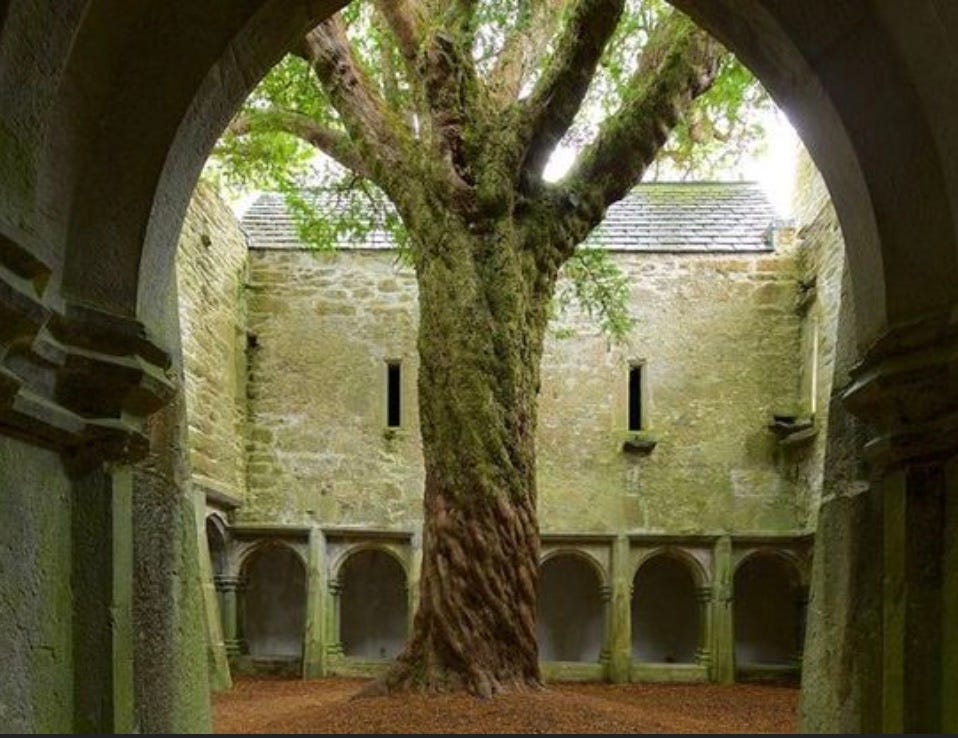As the evening light faded and a cool, dark air descended on the Reenadenna woods, I moved between the Yew trees. Each trunk displayed a patchwork of burgundy and dark ochre, its tiny spear-shaped leaves, a cloak of dark green, hanging in a heavy mass above. The sky barely shows through the canopy, and the silence is pervasive all around. I moved slowly, watching the ground, the uneven dykes and grykes of dissolved sandstone, an alkaline soil, contrasting the acid granite bedrock where the oaks thrive. One false move and your foot can disappear down a hole, a jutting gap, hidden somewhere beneath that lush soft carpet of moss laid down over many years of wet winters in a deep forest shade.
The Yews have a presence. You pass through this wood with a feeling that you are passing through a strange congregation, a house of worship with a doctrine entirely foreign to your own. This is not a place to linger long; it is certainly not a place to make a bed for the night. So you continue moving, and soon every direction begins to look the same. Disorientation can catch you unaware. I have walked through the Reenadeena Yew woods in Killarney National Park every year for the last 25 years, following the same trusted path, snaking between limestone avenues, and still it can happen—complete disorientation—when your guard is down and all of a sudden you are looking into a sea of similar trees with no sense of what direction you began in. At times, I could only retrace my steps by observing the growth of lichens on the tree trunks, which thrive on the north-facing side, the area with the least amount of light.
As I passed between the trees on this particular evening, entirely alone, I heard a rustling, and I stopped. I’ve heard the high-pitched screech of a deer many times and seen them observe my position before they leap and bounce away, but this rustling was close to the ground, close by, nocturnal. I waited behind a tree in silence, my heart beating, barely allowing myself the sound of an intake of breath. A badger, oblivious to my presence, came into view. His nose was close to the ground, moving in a scanning motion left and right, snuffling amongst the moss. He was walking towards me, and I stood there, poised between fascination and reverie, knowing that I should alert him to my presence very soon. But no need, he stopped. Something unexpected, me, alerted his senses, and he looked towards me, two creatures alone now, an encounter in a darkening forest. He turned, and in a movement that I still don’t understand, he simply disappeared. If there was a lair there—a place below ground that he slipped away into—I couldn't find it.
On the northern fringes of the forest, the limestone cliffs drop into the lapping waters of Lough Leane. The beginnings of the Dingle Penninsula are in the distance, with the spire of Killarney Cathedral marking the town's position, and dotted about the waters are the islands: Eagles, Devils, and Inishfallen with its 7th-century abbey ruins. From this lookout, with the dense shade of the evergreen Yews behind you, you can name nine native Irish trees, all growing beside each other within arms reach, growing slow and small in the bare, nutrient-poor soil, but most notably of all, there is a rare Whitebeam (Sorbus aria) growing directly out of the rock face.
The Yew forest of Killarney, the real deep interior, without intentional paths, is not widely known or visited, but it is all the better for it. I have yet to encounter another person in there. My first visit was with a group of conservation volunteers. I remember, as we approached the fringes of the forest, the sun dropped low, and a blaze of unexpected fiery light illuminated the underside of the yews around us. That experience forged itself into my memory.
Since then, I have returned every year on a pilgrimage to that rare thing, becoming rarer by the year—an untouched habitat. In the entirety of the European continent, there are just three significant and notable Yew forests; one of those, possibly the most significant, straddles the fringes of Muckross estate in Killarney. It is a place all of its own.






Hi David
I’m learning a lot from those articles.Well done.
Mum.